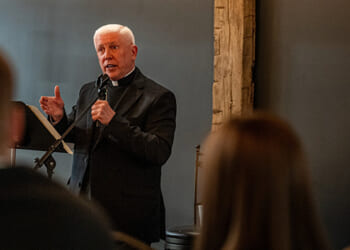
Walking with Moms in Need is a nationwide, parish-based initiative by the United States Conference of Catholic Bishops (USCCB) to connect pregnant and parenting mothers with resources they need to address their challenges.
Launched in 2020, Walking With Moms In Need is a Catholic version of faith-based initiatives seeking to address the needs of women, particularly since the Supreme Court’s Dobbs decision allowed states to regulate abortion.
Kat Talalas, who helped start Walking with Moms in Need, is Assistant Director for Pro-Life Communications in the USCCB’s Pro-Life Secretariat. She spoke with Catholic World Report about the initiative.
CWR: The Supreme Court’s decisions on abortion have twice thrown pro-life work for a loop. In 1973, after years of organizing at the state level, Roe turned abortion into a federal issue, where pro-life institutions were thin. After almost 50 years focused on Washington, Dobbs threw abortion back to the states, where, in many places, pro-life resources were thin. Three years after Dobbs, how do you think we’re doing?
Ms. Talalas: For decades, pro-life warriors across the country have provided significant resources and personal accompaniment to women facing challenging pregnancies. Approximately 2,750 pregnancy help centers all over the United States offer a spectrum of life-affirming services to pregnant and parenting women in need.
That said, whether you are in a state that has laws preventing abortion or a state that allows abortion up to birth, there is always more that can be done to support pregnancy care and to support women in choosing life.
CWR: Returning abortion to the states not only reaffirmed the need for local political organization but, even more so, local practical support. Amy Ford has argued that every Christian church ought to be a resource center for a pregnant woman in need. How are Catholic parishes doing in this regard?
Ms. Talalas: The goal of Walking with Moms in Need is that any pregnant woman should be able to come to any Catholic parish and receive the help that she needs. We are moving forward on this goal!
Our rough estimate is that at least one-third of dioceses are participating in Walking with Moms in Need and have at least some active parishes, and that is a low estimate. Some dioceses start with pilot parishes, like one or two parishes doing the process, while others have 20-30 parishes participating. We’ve only been doing this for five years, and things take a while to move in the Catholic Church, so this is really significant.
CWR: You play a leading role in the Walking with Moms in Need Project, while Chelsy Gomez, as Program Consultant, helps those starting up Walking with Moms in Need in their parishes. Tell us what the Project is about and how it can support pregnant women in need.
Ms. Talalas: Walking with Moms in Need isn’t really a ministry model or a program. It is a process and a framework for a parish to evaluate how they are serving pregnant and parenting moms in need in the community, discovering what resources are available, and prayerfully deciding what they can do uniquely to bridge gaps in services.
It’s basically an “examination of conscience” to see how we are serving the most vulnerable, and a tool to help us decide how we can try to be the hands and feet of Christ to them.
CWR: Walking with Moms in Need aims at getting to know the “lay of the land” in a local parish, inventorying what resources are locally available and where there are gaps. Why is this important?
Ms. Talalas: The inventory is key! There are so many wonderful resources out there: Catholic hospitals offering free or low-cost care; maternity homes offering housing; organizations like St. Vincent de Paul providing material assistance, to name a few. We need to know about them and have that list on hand so that we can be prepared and confidently offer genuine options when we do encounter a woman facing a challenging pregnancy.
As you said, the inventory is also a useful tool to see what isn’t available, so we can think and pray about how our parish can help fill gaps in services.
CWR: Once we know what is and isn’t available locally, what’s next? Given the prevalence of abortion, how do we put that information to work, operationalizing what we now know?
Ms. Talalas: After inventorying, we look to meet needs where there are gaps. If there isn’t a pregnancy center locally, can we start one? Or maybe there is a great pregnancy center—do they have enough volunteers? Part of this step is also “walking in the shoes” of a pregnant woman in your community who is scared and looking for help. Maybe your town has a Catholic health clinic that offers free care to low-income moms; might low-income moms need help getting a ride there if they don’t have a car?
So this step is about looking at where the gaps may be, and prayerfully considering how to fill those gaps so that no one gets left behind.
Another important consideration is awareness and outreach. A community may have a fantastic pregnancy center, but how is the local parish advertising it to people in the community and in the pews? Do people know about the center? Are we regularly communicating about these services in a positive way, so that when someone is in a crisis pregnancy, they know they won’t feel judged in reaching out to us?
Walking with Moms in Need does not compete with any pro-life programs your parish might already have, like the Gabriel Project. If your parish already has an active Gabriel Project or a pregnancy center, Walking with Moms in Need seeks to support, enhance, and advertise the work being done. So if you already have robust pregnancy care support at your parish, Walking with Moms in Need can help ensure everyone at the parish knows about it.
CWR: A local needs assessment is important to Catholic parishes, but doesn’t seem exclusive to them. Do you think other Christian groups could adapt the initiative to their pro-life ministry needs?
Ms. Talalas: Absolutely! Walking with Moms in Need could definitely be utilized in other ecclesial communities, and we hope it will be.
CWR: The USCCB is the “home” of Walking with Moms in Need, but its work has to be done in local parishes. How do we bring this “up-top” idea down to local parishes and implement it? What is the role of laypeople in achieving that?
Ms. Talalas: Walking with Moms in Need is led by regular Catholics who want to serve Christ and save lives! We pray that individual people, even if they have never volunteered at their parish before, will be inspired to bring this idea to their priest and offer to get it started. All the tools and guidance they need to get started are available for free on the Walking with Moms in Need website.
CWR: Walking with Moms in Need is five years old, but I only heard of it recently. How do we get information about it out there?
Ms. Talalas: Start Walking with Moms in Need at your parish and tell your friends!
CWR: If somebody wants to know more, what can they do?
Ms. Talalas: Go to WalkingwithMoms.com . We have videos on the website explaining the program, including a webinar on how to get started. We also have a thorough action guide that explains the whole process, from what to say when you reach out to your pastor, to finding friends to help you, to creating a plan with your parish.
If you value the news and views Catholic World Report provides, please consider donating to support our efforts. Your contribution will help us continue to make CWR available to all readers worldwide for free, without a subscription. Thank you for your generosity!
Click here for more information on donating to CWR. Click here to sign up for our newsletter.












